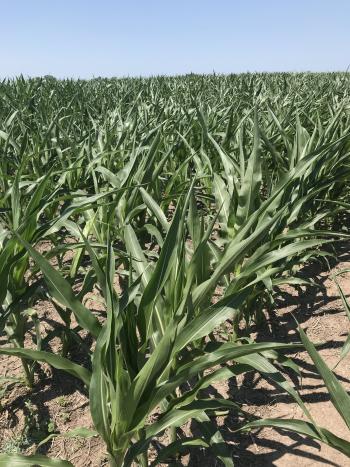July 17, 2019

By Mark Licht, Justin Glisan
The weather forecast for this next week is calling for daytime high temperatures in the 90s and even in the 100s across the state and low nighttime temperatures in the 70s to 80s with little chances of rainfall. This is raising concerns on what impact this can have on the crop, especially with the earlier planted corn starting to tassel and pollinate.
Current weather and outlook
Currently a persistent, upper-level blocking ridge is sitting over the Midwest, preventing air flow and causing a stagnation in our weather pattern. The warmer temperatures and little rainfall can be attributed to this blocking high. The 6-10 day and 8-14 day weather outlook shows higher probabilities of above average temperatures and below average precipitation. The one-month and 90-day outlook are still showing more below normal temperatures and above average precipitation, but those were last updated on June 30.
Flash drought
One term that has been thrown around recently is that we may see what is called a “flash drought”.
What is a flash drought? A flash drought can occur when relatively short periods of anomalously warm air resides over a location, coupled with rapidly decreasing top and sub-soil moisture. There are varying definitions of a flash drought, but there are two general varieties named by the physical mechanisms that create them: heat wave and precipitation-deficit flash droughts.
Flash droughts can form relatively fast over a period of one to two months (hence the name “flash”). Another factor exacerbating a flash drought is less cloud cover that allows more solar radiation to reach the surface, which leads to higher evapotranspiration rates.
Flash droughts differ from classic droughts in that a classic drought forms over a longer seasonal timescale and can be classified in multiple ways. Think of a drought as creeping up while a flash drought happens over a much shorter time frame.
Flash droughts are basically brought on by weather and surface conditions that begin to impact crops and livestock. Given the lack of rainfall over the last 30 days combined with the forecasted unseasonable dryness and warmth, flash drought considerations are being monitored.
Crop Impact
What does this mean for the crops?
Corn: Soil moisture availability is influenced by precipitation as well as rooting depth. April and early May planted crops will have a deeper root system compared to late May and June planted crops. A deeper rooting depth means more soil water available for crop uptake. Additionally, if root systems are restricted due to compaction or insect injury like corn rootworm feeding, this can also make the corn much more susceptible to experiencing moisture stress.
Leaf rolling is often the first distinguishable symptom that the crop is under stress. Leaf rolling is a protective response that limits the exposed leaf area, which in turn reduces transpiration. Corn leaf rolling periodically on hot afternoons does not mean a yield loss is occurring. However, if there are 12 or more hours of consecutive leaf rolling, a grain yield loss will likely occur.
A lot of the April and even some of the May planted fields are tasseling and beginning to pollinate. Pollination is a critical period for corn development and yield and is a time of high water uptake (0.3 to 0.4 inches per day).
In addition to leaf rolling, moisture stress can also slow or delay silk elongation. This raises concerns because the forecasted higher temperatures will increase heat units or Growing Degree Day (GDD) accumulation, which will speed up crop development. The combination of limited soil moisture and higher temperatures could lead to pollen shed prior to silk emergence, resulting in either having a poor “nick” of the pollen and silks or missing the nick.
High temperatures can reduce pollen shed and viability. Pollen shed is limited when temperatures rise above 86oF and temperatures greater than 100oF can kill corn pollen. Consequently, this usually limits pollen shed to mid-morning and early evening.
Pollen shedding occurs over a 5 to 14-day period and “fresh” pollen is available daily. Silk elongation can last up to 10 days, and silks remain receptive up to 10 days following emergence (viability does decrease as the silks age). This can help to minimize the impact and reduce the concern with short-term heat waves.
Soybeans: Effects on soybeans right now are less severe compared to the effects on corn entering pollination. Soybeans respond to drought stress by flipping their leaves so the underside is turned up. Vegetative growth can also be diminished, and flowers or pods may be aborted. However, soybeans can set new flower and pods when conditions improve.
Pests (Insects and Diseases): If conditions stay hot and dry, keep your eyes open for spider mites in both corn and soybeans as they become more of a concern with hot and dry weather. Hot and dry conditions are not very favorable for foliar disease development, but high humidity combined with warm temperatures may be favorable for gray leaf spot development. So far disease pressures has been low. Common rust, eyespot, and gray leaf spot have been the main foliar diseases observed in corn fields.
Source: Iowa State University
The source is solely responsible for the information provided and is wholly owned by the source. Informa Business Media and all its subsidiaries are not responsible for any of the content contained in this information asset.
You May Also Like




